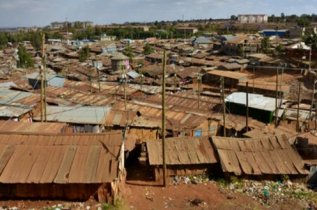|
|
|
Kibera Slum |
Kibera Slum |
Kibera Slum | Kibera Slum |

|

 Kibera was home to some 6,000 residents. In twenty years that figure increased ten-fold and was estimated to be nearly half a million by the turn of the century as the run down area attracted the poor and those fleeing conflicts both within Kenya and neighbouring countries. The slum today has few services such as schools, clinics, just two main water points from a water treatment plant: one built by the Nairobi municipality and the other one by the World Bank. The sanitation system is worse with a single latrine being shared on average by up to 50 shacks with the waste, when the latrines are full, being carried by children to the Motoine-Ngong River, now pretty much an open sewer also polluted by tons of garbage generated in Kibera. Residents of the slum typically live in homes made from mud and metal that are normally about 12ft by 12ft costing about six pounds a month to rent and are normally occupied by eight people with only 20% of the slum population having electricity. Conditions are appalling with garbage and raw sewage spewing from every location making daily life hazardous especially for children who use these places as playgrounds. The stench from this rubbish and sewage is overwhelming and ever present. Without healthcare facilities many of these children die from diseases caught from the sewage. Malaria and HIV/AIDS are also rampant with 60% of Kibera's population infected in addition to typhoid and now a rampant Covid. Life expectancy in Kibera is just 30 years. Cont/... Kibera is hardly the place to bring up children, where one in five is dead before their fifth birthday, however as there are no contraception programs, it is estimated that at any given time half the women aged between 16-25yrs are pregnant and one in three children is an orphan. Many of these children inevitably end up on the streets. These children in Kibera are particularly vulnerable to abuse, having to either live alone or with other youths. It's a sad fact that solvent abuse, mainly glue, is rampant in the slum and often the children will walk into Nairobi to steal and pick pocket on the streets both to buy glue and have enough to buy the food that's available from small market stalls in Kibera. Today it is believed Kibera Slum has a population of just over 250,000, though some claim as high as a million, although a lower figures is now more likely given the Kenyan government's ongoing attempts to redevelop the area although this has often been delayed not least because of court challenges and finance. The redevelopment has had other consequences, mainly due to a lack of planning, not least where the residents are expected to live after their shanty homes are razed to the ground. For example, previously when a new road was built on the land lived in by Kibera residents, not only did those residents lose their few worldly goods, but they simply ended up cramming into an existing neighbouring slum building. Despite attempts and the ceasless work of charities to improve the slum, one government official has stated that at the curent pace of progress, the relocation of Kibera's residents and redevelopment scheme will take 1,178 years to complete. |







